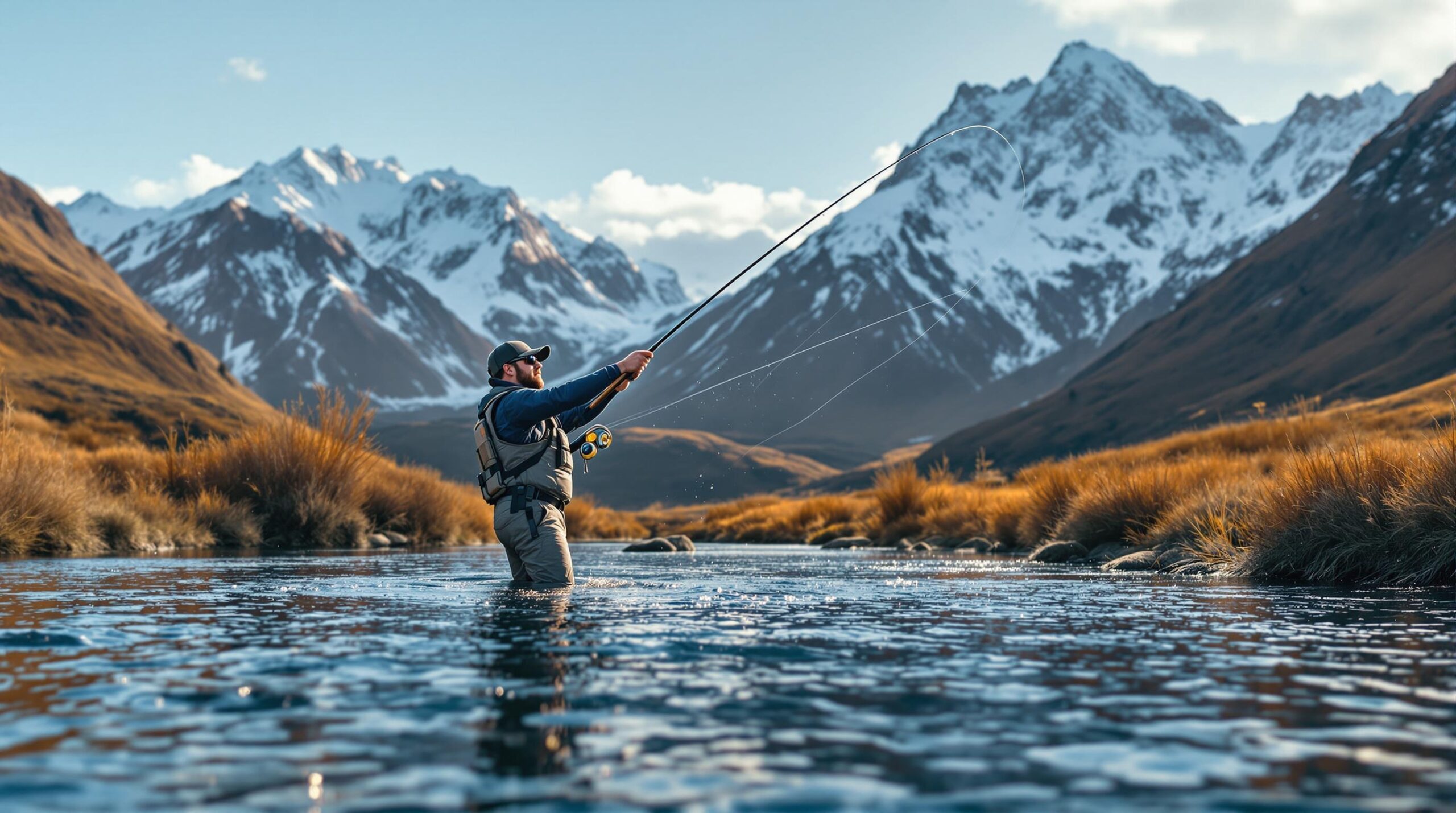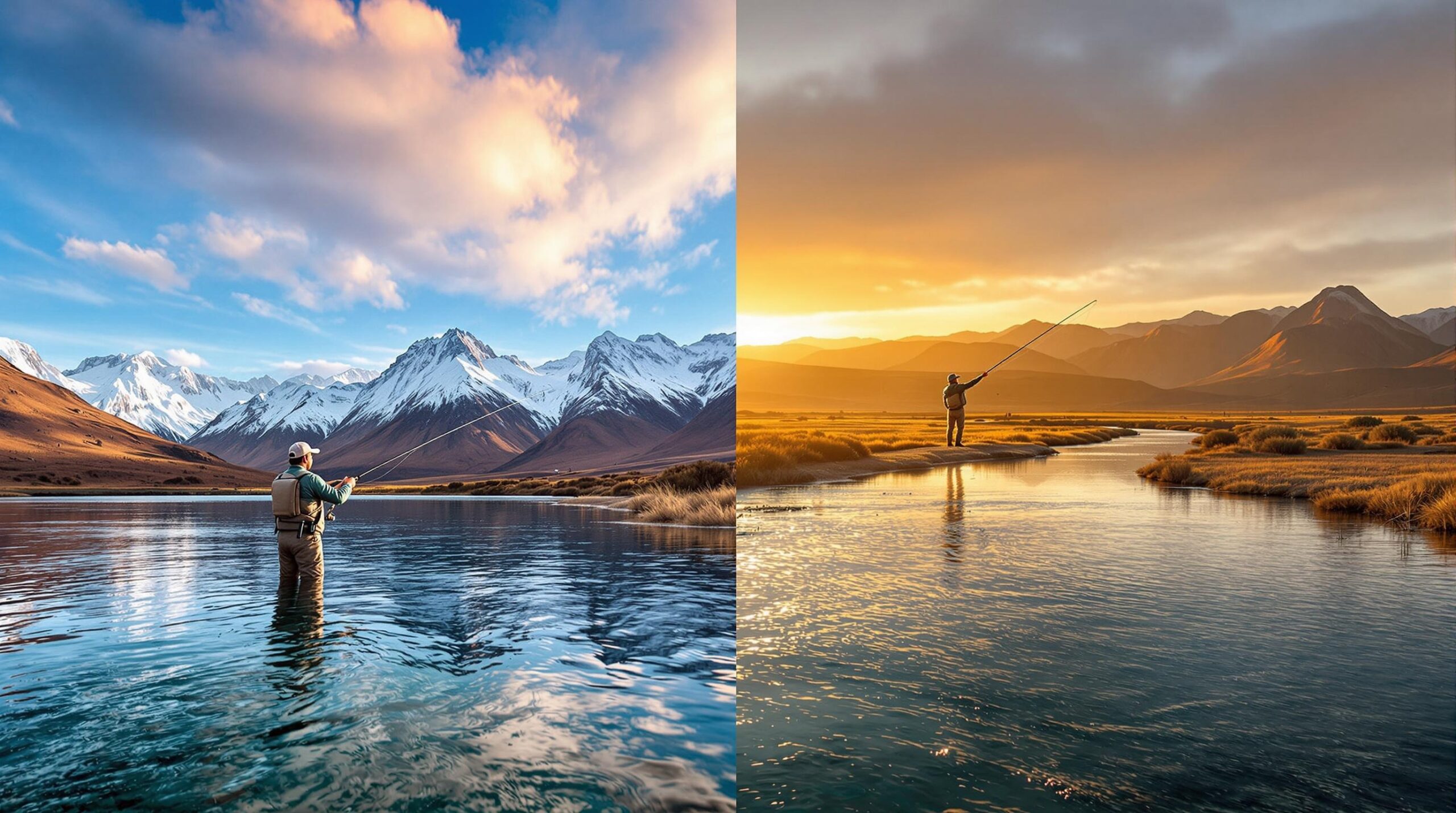According to Flyfisherman Magazine, South American fly fishing destinations generate over $2.8 billion annually in angling tourism, with Chile and Argentina capturing 65% of this market through their premium fly fishing travel packages. These neighboring nations offer dramatically different angling experiences—from Chile’s technical spring creek fishing amid towering Andes peaks to Argentina’s explosive brown trout waters in vast Patagonian steppes—making the choice between them a defining decision for serious anglers planning their next adventure.
Key Takeaways
- Chilean fly fishing travel packages focus on technical fishing in pristine mountain environments with smaller, educated trout
- Argentine destinations offer explosive action with larger fish in expansive pampas and steppe landscapes
- Chile provides year-round fishing opportunities while Argentina’s prime season runs October through April
- Both countries offer world-class lodges but differ significantly in fishing styles and target species
- Budget considerations vary dramatically, with Chilean fly fishing travel packages typically costing 15-25% more than comparable Argentine options
Geographic and Environmental Differences
Chile’s fly fishing destinations stretch along a narrow corridor between the Pacific Ocean and Andes Mountains. This unique geography creates distinct microclimates and water systems that shape the angling experience.
The Chilean Andes create snowmelt-fed rivers that run crystal clear through volcanic landscapes. Water temperatures remain cool year-round, supporting healthy populations of rainbow and brown trout. Most Chilean rivers feature technical pocket water and require precise presentation skills.
Argentina’s fishing regions span massive geographic areas from Patagonian steppes to high-altitude lakes. The eastern slopes of the Andes receive less precipitation, creating different water characteristics than their Chilean counterparts.
Argentine waters tend to be nutrient-rich with higher insect populations. This abundance supports larger fish populations and creates the aggressive feeding behavior Argentine waters are famous for. Many Argentine rivers flow through open grasslands, offering easier wading and casting opportunities.
Prime Fishing Seasons and Climate Patterns
Chilean fly fishing travel packages operate on Southern Hemisphere seasons, but the country’s unique geography creates extended fishing opportunities. The northern regions fish well from September through May, while southern areas peak from November through April.
Chile’s maritime influence moderates temperature swings. Anglers can expect daytime temperatures between 60-75°F during peak season, with cool nights requiring layered clothing. Rain is common but typically comes in short bursts rather than extended periods.
Argentina’s continental climate creates more dramatic seasonal variations. The prime fishing season runs from October through April, with peak conditions from December through March. Summer temperatures can reach 85°F during the day but drop significantly at night.
Argentine Patagonia is famous for its wind, particularly in spring and early summer. This weather pattern affects fly selection and casting techniques, making it essential for anglers to prepare accordingly.
Species Composition and Fish Behavior
Chilean waters primarily hold rainbow and brown trout, with some brook trout in higher elevation streams. The fish tend to be smaller on average—12-16 inches is typical—but they’re selective and technically challenging.
Fly fishing in Chile requires precise presentations and small flies. The clear water means fish can inspect offerings closely, making leader selection and fly choice critical. Terrestrial patterns work well during summer months, while nymph fishing dominates during cooler periods.
Argentine waters support larger fish populations with different behavioral patterns. Brown trout averaging 16-20 inches are common, with fish over 24 inches caught regularly. The abundant food sources create aggressive fish that often chase streamers and large dry flies.
Fly fishing in Patagonia Argentina allows for more varied techniques, from mouse patterns fished at night to terrestrial fishing during windy conditions. The fish are generally less selective, making it an excellent destination for anglers wanting consistent action.
Lodge Options and Accommodation Styles
Chilean fly fishing travel packages typically center around boutique lodges with 6-12 guests maximum. These intimate settings provide personalized service and access to exclusive water. Most Chilean lodges emphasize sustainability and environmental stewardship.
Best fly fishing lodges in Chile often feature gourmet cuisine using local ingredients, wine pairings, and spa services. The focus is on creating a complete luxury experience rather than just fishing accommodation.
Argentine lodges range from intimate estancias to larger operations hosting 20+ guests. Many Argentine lodges are converted cattle ranches, offering a different cultural experience with traditional asado barbecues and gaucho demonstrations.
Argentine fly fishing travel packages often include multiple lodges or camps, allowing anglers to experience different water types during a single trip. This variety is harder to achieve in Chile due to the more limited geographic scope.
Access and Transportation Considerations
Chilean fishing destinations typically require connecting flights from Santiago to regional airports. Most lodges provide ground transportation, but distances can be significant. The narrow geography means most destinations are accessible within a day’s travel.
Road conditions in Chile are generally excellent, with well-maintained highways connecting major fishing regions. However, access to remote waters often requires 4WD vehicles and experienced local guides.
Argentine fishing regions are more spread out, with some destinations requiring multiple connections or charter flights. Buenos Aires serves as the primary hub, with connections to Bariloche, El Calafate, and other regional airports serving fishing areas.
Ground transportation in Argentina can involve longer drives on gravel roads, particularly when accessing remote estancias. This travel is part of the adventure but requires more time allocation in trip planning.
Cost Analysis and Value Propositions
Chilean fly fishing travel packages command premium pricing due to limited capacity and exclusive access. A week-long package typically costs $4,500-$7,500 per person, including accommodation, meals, guides, and ground transportation.
The higher cost reflects smaller guest numbers, pristine environments, and technical fishing challenges. Chilean lodges often include premium amenities like wine cellars, gourmet dining, and spa services as standard offerings.
Argentine fly fishing travel packages offer more variety in pricing, ranging from $3,200-$6,000 per person for comparable packages. The lower costs reflect larger lodge capacities and different service models, though quality remains high.
Argentine packages often include more fishing time due to longer daylight hours and multiple water access points. The value proposition centers on fish numbers and size rather than exclusivity and technical challenge.
Water Types and Fishing Techniques
Chilean waters feature spring creeks, freestone rivers, and high-altitude lakes. The spring creeks require the most technical skills, with crystal-clear water and highly educated fish demanding perfect presentations.
Freestone rivers in Chile flow through volcanic terrain, creating pocket water that holds fish but challenges casting accuracy. Lake fishing involves both trolling and sight-fishing techniques, particularly effective during mayfly emergences.
Argentine waters include large rivers, stillwaters, and smaller streams. The Limay, Chimehuin, and Malleo rivers are famous for their brown trout populations and varied fishing opportunities within single systems.
Stillwater fishing in Argentina often involves stalking fish in shallow bays or fishing during evening emergences. The large size of many Argentine waters allows for different techniques on the same day, from nymphing deep pools to casting streamers along undercut banks.
Seasonal Hatches and Fly Patterns
Chilean fly fishing travel packages need to account for specific hatch timing. Mayfly emergences typically begin in November and continue through March, with peak activity during January and February. Caddisfly hatches overlap mayfly emergences and continue later into the season.
Terrestrial fishing becomes important from December through April, with ant and beetle patterns particularly effective during windy conditions. Small streamer patterns work year-round but are most productive during cooler months when fish are less surface-active.
Argentine waters support more diverse insect populations due to varied habitats and climates. Mayfly hatches begin earlier—October in northern regions—and continue through April in southern areas.
The abundance of baitfish in many Argentine waters makes streamer fishing highly productive. Mouse patterns are particularly effective during night fishing, while terrestrial patterns dominate during daylight hours in late summer.
Cultural Experiences and Local Interactions
Chilean fly fishing travel packages immerse anglers in a culture that blends European influences with indigenous traditions. Wine country proximity means many packages include vineyard visits and wine-tasting experiences.
Local guides in Chile often have generations of experience on specific waters. This knowledge extends beyond fishing techniques to include natural history, geology, and cultural stories that enrich the angling experience.
Argentine fishing culture reflects the country’s ranching heritage. Many lodges incorporate traditional gaucho activities, from horseback riding to cattle-working demonstrations. The emphasis on hospitality and social interaction creates memorable experiences beyond the fishing.
Argentine cuisine features prominently in fly fishing travel packages, with asado barbecues and wine pairings becoming anticipated daily events. The social aspect of Argentine culture enhances the overall trip experience for many anglers.
Equipment and Preparation Requirements
Chilean fishing demands specific equipment considerations. Rods should be 9-foot 4-6 weight outfits capable of precise presentations. Longer rods help with line control in pocket water situations common throughout Chilean rivers.
Leader systems need to be longer and lighter than typical trout fishing setups. 12-15 foot leaders tapered to 6X or 7X tippets are standard. Clear intermediate lines work well for lake fishing, while floating lines handle most stream situations.
Argentine fishing allows for more varied equipment choices. 9-foot 5-7 weight rods handle most situations, though 8-weight outfits are useful for streamer fishing and windy conditions. Multiple rod setups allow anglers to capitalize on changing conditions throughout the day.
Wading gear should be chosen based on specific destinations. Chilean streams often require felt-soled boots for volcanic rock, while Argentine waters may need studded soles for algae-covered stones. Water temperatures dictate wader choices, with breathable chest waders recommended for most situations.
Weather Patterns and Clothing Considerations
Chilean fly fishing travel packages require layered clothing systems due to variable mountain weather. Morning temperatures may start near freezing, reach 75°F by midday, then drop rapidly as afternoon winds develop.
Rain gear is essential in Chile, as weather patterns can change quickly. Lightweight, breathable rain jackets and pants should be packed for every trip. Insulating layers like fleece or down vests provide warmth during cool mornings and evenings.
Argentine weather patterns are more predictable but potentially more extreme. Strong winds are common, particularly during spring months. Wind-resistant clothing and secure hat retention systems prevent equipment loss during casting.
Sun protection becomes critical in Argentina’s high-altitude and open terrain environments. UV-protective clothing, quality sunglasses, and broad-brimmed hats are essential equipment rather than optional accessories.
Photography and Documentation Opportunities
Chilean landscapes provide dramatic backdrops for fishing photography. Snow-capped peaks, volcanic lakes, and pristine rivers create compelling compositions. The clear water allows for underwater fish photography when conditions permit.
Lighting conditions in Chile can change rapidly due to mountain weather patterns. Photographers should be prepared for everything from harsh midday sun to moody overcast conditions that enhance landscape images.
Argentine scenery offers different photographic opportunities, from vast pampas landscapes to intimate stream scenes. The open terrain provides excellent wildlife photography opportunities, with condors, guanacos, and various bird species commonly observed.
Golden-hour lighting in Argentina can be spectacular, particularly during late summer when the grass takes on rich colors. The dramatic skies common to Patagonian regions create memorable sunset and sunrise images.
Conservation and Environmental Considerations
Chilean fly fishing travel packages emphasize environmental stewardship. Many lodges participate in habitat restoration projects and fish population monitoring programs. Catch-and-release practices are strongly encouraged or mandated on most waters.
Water quality in Chile faces pressure from agricultural development and mining activities in some regions. Choosing lodges that actively support conservation efforts helps protect these valuable fisheries for future generations.
Argentine conservation efforts focus on habitat protection and invasive species management. Some regions have implemented strict regulations on bait fishing and harvest limits to protect wild trout populations.
Sustainable tourism practices in Argentina include supporting local communities and minimizing environmental impact. Many lodges employ local guides and staff, contributing to regional economic development while maintaining cultural authenticity.
Travel Logistics and Entry Requirements
Chilean fly fishing travel packages require valid passports but no visa for most visitors staying under 90 days. Entry through Santiago’s international airport provides connections to regional destinations serving fishing areas.
Currency exchange is straightforward in Chile, with US dollars accepted at many lodges. Credit cards are widely accepted, though having local currency helps with gratuities and incidental expenses.
Argentine entry requirements are similar to Chile, with passport-only entry for most visitors. Buenos Aires serves as the primary international gateway, with domestic connections to fishing regions.
Argentine currency situations can be complex due to official and unofficial exchange rates. Many lodges quote prices in US dollars and prefer cash payments. Understanding current currency regulations helps avoid complications during travel.
Frequently Asked Questions
What’s the best time to book fly fishing travel packages for Chile vs Argentina?
Book Chilean packages 8-12 months in advance for prime February-March dates. Argentine packages require 6-10 months advance booking for December-February peak season.
How do fishing techniques differ between Chilean and Argentine waters?
Chilean fishing emphasizes technical dry fly and nymph presentations in clear water. Argentine fishing allows aggressive streamer techniques and larger flies due to more fertile waters.
Which destination offers better value in fly fishing travel packages?
Argentina typically offers 15-25% cost savings compared to Chile, with larger fish and more action. Chile provides exclusive access and technical challenges worth the premium pricing.
What equipment differences are needed for Chile vs Argentina fly fishing?
Chile requires lighter tackle (4-6 weight rods) and longer leaders for technical presentations. Argentina allows heavier gear (5-8 weight) for streamers and windy conditions.
How do lodge styles differ between Chilean and Argentine fly fishing travel packages?
Chilean lodges emphasize intimate, boutique experiences with 6-12 guests maximum. Argentine lodges range from intimate estancias to larger operations with varied accommodation styles.
Which country offers more diverse fishing opportunities within single packages?
Argentina provides more water variety within single packages due to larger geographic regions. Chile focuses on specific watersheds with consistent fishing styles throughout packages.
Sources:


